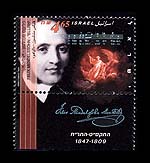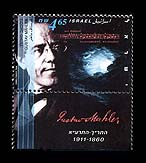|
Both of these fine composers lived and worked in the 19th century - one in the first half of the century, and the other in the second half. Both were assimilated Jews, who contributed greatly to German culture. They both converted to Christianity, one through his father, and the other to promote his career. However, each of them remained very Jewish in their souls, and there are those who claim that this can be heard in their music.
Felix Mendelssohn (1809 - 1847), Born in Hamburg to the banker Avraham Mendelssohn, who was son of the philosopher Moses Mendelssohn. His father baptized him as a Christian when he was born, and gave him the name Bartholdy, a name Mendelssohn himself never liked and avoided using. He and his sister Fanny, who was a little older than himself, and an extremely accomplished musician herself, grew up in a wealthy, culturally rich home, where they received an excellent education. The most accomplished artists of the time visited their home regularly, and the children's talents were much encouraged.
Mendelssohn was an amazingly talented child, who from an early age astounded his audiences with his versatility. He was a gifted pianist, conductor, composer and singer, as well as an actor and painter. When he was 16 years old, he composed the overture to Shakespeare's A Midsummer Night's Dream, a work considered a classic today. His relatively short life represents a continuum of fruitfulness and creativity. Mendelssohn frequently travelled to Europe, particularly Italy and England. The British gladly adopted him, and continually invited him to appear as a pianist, conductor and composer. His works, considered among the finest of the 19th century, include an obviously Jewish element: passages from the Book of Psalms for choir and the oratorio Elijah, his most impressive and last work. Mendelssohn contributed to the cultural life in Germany by organizing music festivals in various cities. He is also credited with turning Leipzig into an important music centre, It was here that he set up the Gewandhaus Orchestra, and founded and presided over the conservatory. Mendelssohn died at the young age 38. When the Nazis came to power, his music was banned, and his statue was destroyed. Leipzig has recently decided to grant Mendelssohn the honour he rightfully deserves.
Gustav Mahler (1860 - 1911) Born in Kalischt, Bohemia to a middle class Jewish family. At the age of 15 he was sent to Vienna to study music at the conservatory with Anton Bruckner. He was renowned as an outstanding conductor from the age of 20, and he worked in opera houses in Kassell, Prague, Leipzig, Budapest and Hamburg. In 1897 he was appointed director of the Vienna Royal Opera, and in order to ensure the position, he converted to Catholicism. From 1898 to 1901 he conducted the Vienna Philharmonic Orchestra.
He raised both of these institutions to heights unknown both prior to his era and afterwards. His repertoire centred around the operas of Wagner and Mozart, and his performances are considered worthy of emulation to this day. In 1907 he left his position in Vienna and moved to New York, where he served as conductor for the Metropolitan Opera and the Philharmonic Orchestra. He left New York disillusioned, and returned to Vienna, where he passed away.
In addition to his heavy schedule as conductor and art director, Mahler composed music during the summer months he spent on his own in the mountains. While he conducted operas, most of the pieces he wrote were symphonies and songs. Mahler composed nine full symphonies, and had begun a tenth. His famous song collections include: Songs of a Wandering Apprentice, Songs on the Death of Children, and The Ruckert Songs. His most famous composition Song of the Earth is a unique synthesis of symphony and song. When first performed, the works were considered innovative and daring, though they were well received by the public. Interest in his works has increased in recent decades, and they are currently performed in symphony halls the world over, and are recorded by a number of orchestras.
Felix Mendelssohn
Pictured on the right-hand side of the stamp is a section of
an engraving by the painter Gustave Dore portraying the Prophet
Elijah's ascent to heaven in a chariot of fire. Appearing
above the engraving is an excerpt from the score of fhe
'Elijah oratorio, opus 70, number 38. The text of the
oratorio is taken from the Book of Kings and describes
Elijah's ascent to heaven. For mixed voice choir and
soloists. The composition was completed in 1846.
Gustav Mahler
The section of the engraving describes the creation of the
Primordial Light. The score segment is from Symphony No. 2 in
C minor ("Resurrection Symphony"), the end of the
fourth movement - "Urlicht". The text is taken from
"Des Knaben Wunderhorn" ("The Youth's
Magic Horn"). For a large orchestra, soprano and alto
solo and mixed voice choir. The composition was completed in
1894.


